This technology consists of two alternating pits connected to a pour flush toilet. The blackwater (and in some cases greywater) is collected in the pits and allowed to slowly infiltrate into the surrounding soil. Over time, the solids are sufficiently dewatered and can be manually removed with a shovel and reused on-site, much like compost, to improve soil fertility and fertilise crops . Although most pathogens are filtered during soil infiltration or die-off with time and distance, there remains a risk of groundwater pollution, particularly in densely populated areas or in areas with a high groundwater table.
| In | Out |
|---|---|
Compost/Biosolids |
Twin-pit for pour-flush toilets are improved pit latrines, which allow on-site treatment and transformation of faecal sludge into a hygienized soil amendment. They have been constructed over the past 30 years mainly in India, Bangladesh and Nepal. They basically consist of two pits (similar in design to soak pits), which are linked, using a Y-junction, to a single pour-flush toilet.
The twin pits for pour flush technology can be designed in various ways; the toilet can be located directly over the pits or at a distance from them. The superstructure can be permanently constructed over both pits or it can move from side to side depending on which one is in use. Often pits are placed symmetrically at the back of the latrine in order to have good access an ensure drainage from the user interface to the pits.
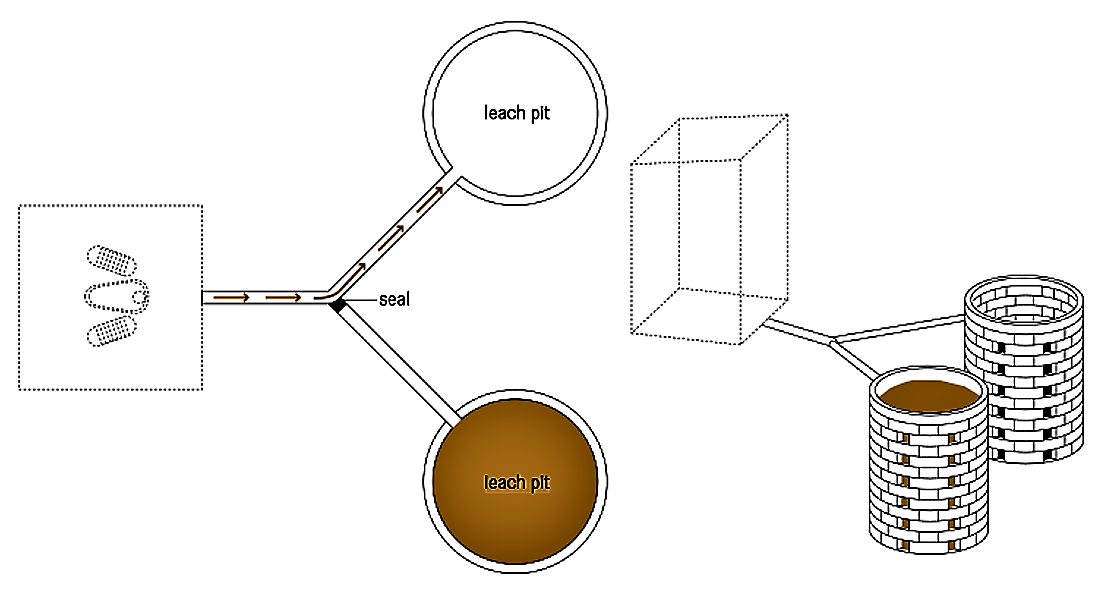
If site conditions do not permit this layout, the pits can be placed on the side or even in front of the toilet pan, but this design requires more water for flushing (ROY et al. 1984). Toilets can also be constructed inside the house, while the pits can be situated outside the house. However, the pits should not be situated in drainage lines, the paths of stormwater drains or in depressions where water is likely to collect in order to prevent water from entering the pit which can cause groundwater pollution or destabilize the constructions.
The pit shape can be circular or rectangular, but circular pits are more stable and cost less (ROY et al. 1984). No matter how the system is designed, only one pit is used at a time. While one pit is filling, the other full pit is resting.
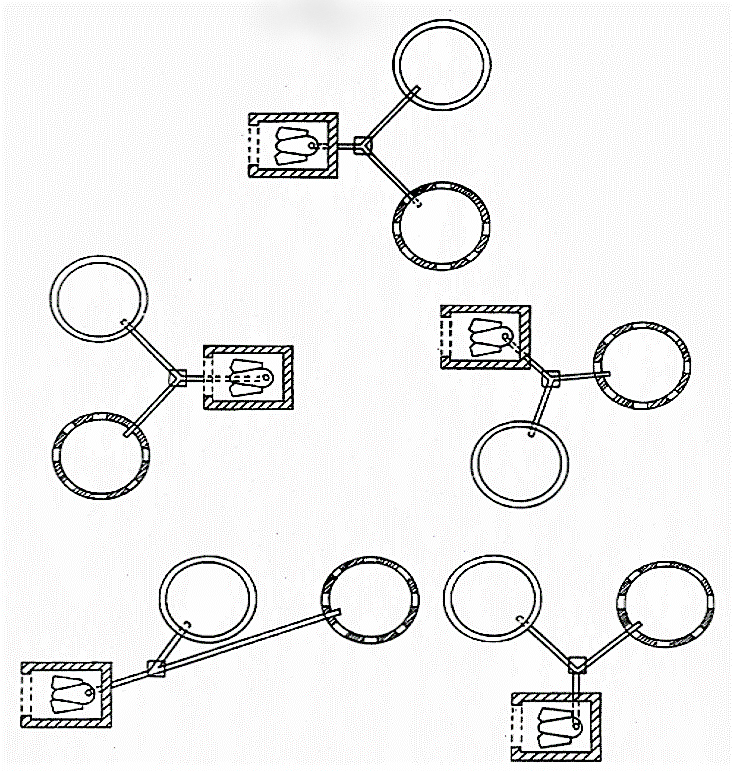
During storage, excreta decompose by a combination of anaerobic digestion and composting processes. The end product is hygienised and can be used as soil amendment (i.e. compost) to improve soil structure and increase water storage capacity and fertility. This transformation process takes approximately two years.
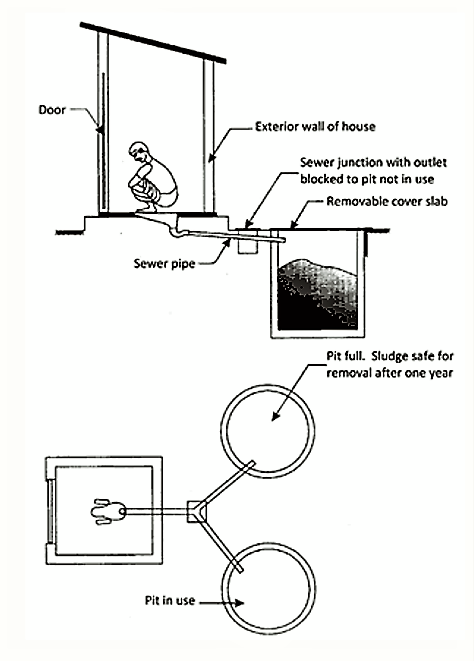
As liquid leaches from the pit and migrates through the unsaturated soil matrix, pathogenic germs are sorbed onto the soil surface. In this way, pathogens can be removed prior to contact with groundwater. The degree of removal varies with soil type, distance travelled, moisture and other environmental factors.
The difference between this technology and other technologies such as composting toilets, the arborloo, the double VIP or Fossa Alterna is that it allows for water (flushing water, anal cleansing water, greywater) and it is not necessary to add soil or organic material to the pits. As this is a water-based (wet) technology , however , the full pits require a longer retention time (two years is recommended) to degrade the material before it can be excavated safely.
The pour-flush squatting pan consists of a steep bottom slope and a water seal trap (see also pour-flush toilet). From there, faeces, urine and flushing water are directed to one of two leach pits. The pits are connected via an inspection chamber containing a Y junction allowing the channeling of the blackwater into either one or the other pit (WHO 1992). The pits should be of an adequate size to accommodate a volume of waste generated over one or two years. This allows the contents of the full pit enough time to transform into a partially sanitized, soil-like material that can be manually excavated. For a family of 5 members, a pit about 1 m deep and 1 m around should be enough for three years (HESPERIAN FOUNDATION 2004). After excavation, the soil-like material can be used as soil amendment in kitchen gardens or field or in agriculture (see also use of compost or reuse of urine and faeces in agriculture). In case of humid sludge, it can be composted or dried before reuse (WHO 1992).
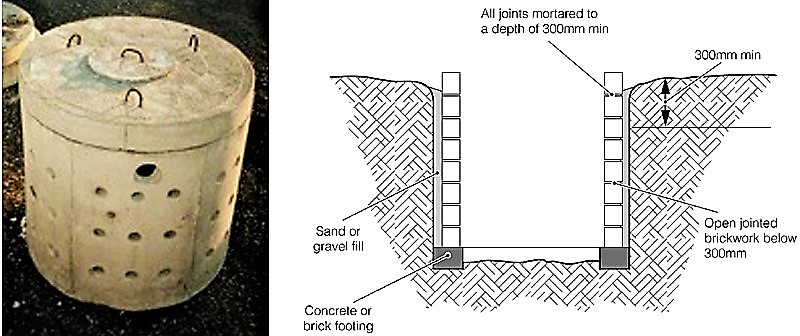
The pits are either constructed with a porous material, in open-joint brick lines (like a honeycomb, to facilitate the liquid to flow out) or with perforated concrete tubes (i.e. pre-fabricated). It is recommended that the twin pits be constructed 1 m apart from each other to minimize cross-contamination between the maturing pit and the one in use. If the spacing between the two pits has to be reduced, an impervious barrier should be provided between them. It is also recommended that the pits be constructed over 1 m from any structural foundation as leachate can negatively impact structural supports. Water within the pit can impact its stability. Therefore, the full depth of the pit walls should be lined to prevent collapse and the top 30 cm should be fully mortared to prevent direct infiltration and to support the superstructure. Moreover, the pits should be covered with a wooden or concrete slab.
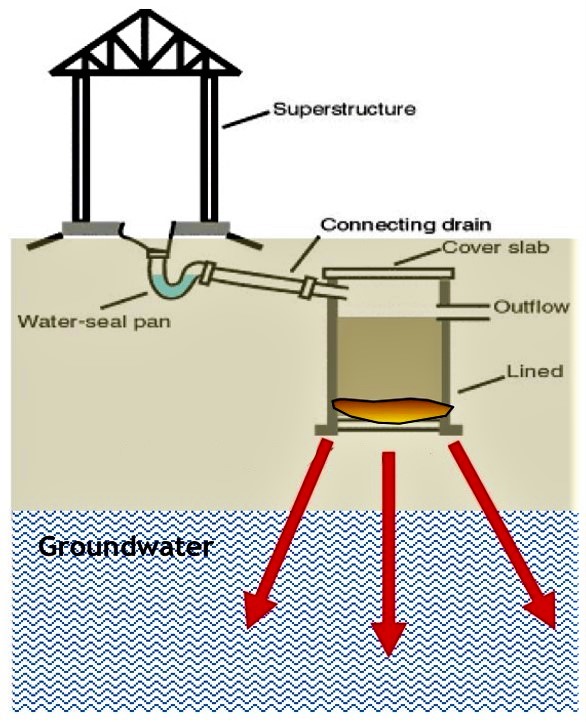
There is a risk of groundwater pollution when pits are located in areas with a high or variable water table, and/or fissures or cracks in the bedrock. As soil and groundwater properties are often unknown, it is difficult to estimate the distance necessary between a pit and a water source. In alluvial soils (silt mixed with fine sand) and where the pit bottom is at least 2 m above the maximum ground-water level (ROY et al. 1984; WSP 2008), there is genera
lly no risk. But in water-saturated soils, virus and bacteria can travel hundreds of meters. It is normally recommended to have a minimum horizontal distance of 30 m between them to limit exposing the water source to microbial contamination. The table below gives some further guidelines for minimal distances of the leach pits from drinking water sources.
| Distance between bottom of the pit and the maximum groundwater table | Effective size of the formation soil | Minimum horizontal distance from drinking water source | Modification needed |
| > 2 m | < 0.2 mm (fine sand, clay and silt) | 3 m | None |
| > 2 m | > 0.2 mm (coarse sand) | 3 m | Provide envelope of sand and impermeable pit bottom |
| < 2 m | > 0.2 mm (coarse sand) | 10 m | Provide envelope of sand and impermeable pit bottom |
| < 2 m | < 0.2 mm (fine sand, clay and silt) | 10 m | None |
Minimal distance of leach pits from drinking water sources in different soil conditions. Source: ROY et al. (1984)
To ensure that only one of the two pits is used at any time, the idle pipe of the junction connecting to the out-of-use pit should be closed (e.g. with cement or bricks). Alternatively, the pour flush toilet could also be directly connected to the pit in use by a single straight pipe fixed in place with light mortar and covered with earth. The risk of failure and misuse is minimized by ensuring that the junction and pipes are not easily accessible.
As almost any toilet, twin-pit pour-flush can be easily adapted for urine diversion (see also urine diversion components). The aim of such an adapted can either be the collection of the urine as a fertilizer or the prevention of too much nutrients and liquids flowing through the pit. In Nepal, for instance, over 190 such systems have been installed by ENPHO. The toilets are designed the same way as twin-pits for pour-flush toilets, but with a urine diversion slab or pedestal and a urine collection chamber. The collected urine can be easily used as a nitrogen-rich fertilizer. The faeces are flushed with water and are collected along with water used for cleansing in the twin pits. The urine-diversion twin-pit pour-flush toilets have the advantage (compared to urine diversion dehydration toilets) that cleansing water does not need to be diverted separately, but can be flushed down the pan, together with the faeces. This generally results in high social acceptance.
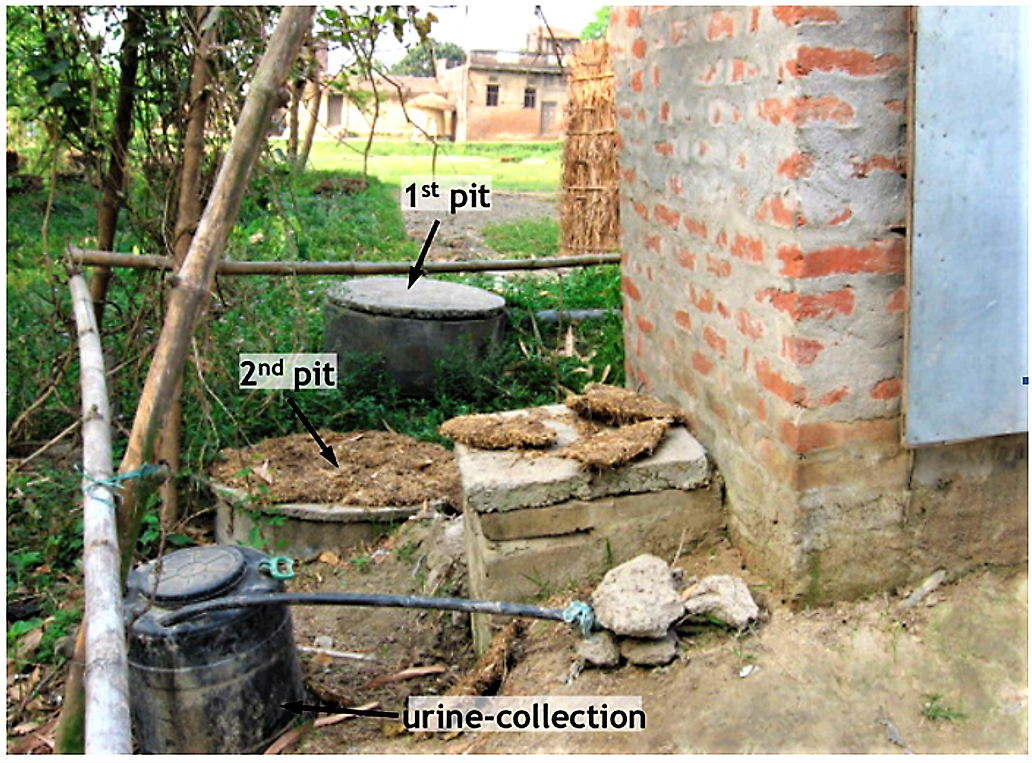
It is a commonly accepted sanitation option; however, some health concerns exist:
- Leachate can contaminate groundwater;
- Stagnant water in pits may promote insect breeding;
- Pits are susceptible to failure and/or overflowing during floods.
The most important operation and maintenance actions are to control the filling of the pit in use in order to change to the other at the right moment and to correctly seal the Y junctions for the pit not in use. The pits must be regularly emptied (after the recommended two year resting time), and care must be taken to ensure that they do not flood during rainy seasons. Pits should therefore be covered and sealed on one hand to prevent surface rainwater from flowing into the pits and on the other hand to protect people and animals from falling into it.Moreover, any fresh blackwater needs to be prevented from entering into the resting pit during the two year storage period. Therefore, the seal in the Y junction must be controlled occasionally. Emptying is done manually using long handled shovels and proper personal protection.
Before starting the filling phase of a pit, a layer of soil (15 cm) should be filled in the bottom of the pit (ROY et al. 1984).
During toilet use, it is important to flush with 1.5 to 2 L (ROY et al. 1984), so that the excreta are transported to the pits and do not clog in the water seal. If dry material is used for cleansing (e.g. toilet paper), the risk of clogging is high.
Fly and odour control can be improved by the periodic additive of ash into the pit. This will also improve the productivity of the maturated sludge as a fertilizer.
As every toilet, the pour-flush toilet needs to be cleaned regularly. It is important not to use too much water for washing to prevent fast filling up. Even though greywater can be poured into the toilet if there is no other reuse option (e.g. in a greywater tower), it should not be added in large volumes because this would cause overflow of the pit or enhanced leaching. Also solid waste (kitchen waste, sweepings etc.) should not be added, as this would cause clogging of the pour-flush pan.
In any case, long-term support facilities to remind and assist the user in changing and emptying pits will greatly improve operational success (WHO 1992).
The construction of twin pits for pour-flush toilets can be rather expensive depending on the local availability of manpower and construction material (about 1.5 of the costs of normal pit latrines, WSP 2004). However, once the twin pits have been installed, they can virtually be used without end.
| Working Principle | Two leach pits (twin pits) are linked to a pour-flush toilet with a Y junction. Only one pit is used at a time as the Y junction is blocked for the other. When it is full, the pit is sealed and the other is brought in use. The excreta in the sealed pit will decompose by composting and anaerobic digestion. After two years, the maturated sludge is safe but rich in nutrients and can be used in agriculture. |
| Capacity/Adequacy | Can be built in rural and urban areas if water and space are available. But in regions prone to flooding or with rocky soils, groundwater pollution can occur. Also, if too many soak pits are installed densely, they can rapidly overflow or lead to groundwater pollution, as the soil matrix cannot absorb all the leachate. |
| Performance | Liquids, if filtered through underground infiltration will by purified without having been in contact with humans or animals. The faeces hygienisation takes relatively long (2 years) as it is a water-reliant process but the end product is safe. |
| Costs | Moderate to high investment costs; very low operation and maintenance costs |
| Self-help Compatibility | Can be constructed with local manpower, but skilled design is required. |
| O&M | Control of Y junction; Desludging every two years. |
| Reliability | High, if well maintained. |
| Main strength | Easy to use and high comfort (anal cleansing with water, no odour). |
| Main weakness | Requires water for flushing, otherwise it clogs; Risk of groundwater pollution. |
Twin pits for pour flush require little change from the user, produce additional fertiliser and are easily accepted, as there is no odour due to the water seal. They are a permanent technology appropriate for areas where it is not possible to continuously build new pit latrines. As long as water is available, this technology is appropriate for almost every type of housing density. However, too many wet pits in a small area is not recommended as the soil matrix may not be of sufficient capacity to absorb all the liquid and the ground could become water-logged (oversaturated). In order for the pits to drain properly, the soil must have a good absorptive capacity; clay, tightly packed or rocky soils are not appropriate. This technology is not suitable for areas with a high groundwater table or where there is frequent flooding.
Greywater can be co-managed along with the blackwater in the twin pits, especially if the greywater quantities are relatively small, and no other management system is in place to control it. However, large quantities of flushwater and/or greywater may result in excessive leaching from the pit and possibly groundwater contamination. If there is not enough water available for flushing, the toilet may be constructed without water seal. But in this case the addition of ash to the pits and a plug on the squatting hole should be used for odour and fly control .
The dewatered, solid material is manually emptied from the pits (it is dug, not pumped out), therefore, space is not required for vacuum trucks to access them.
Bogs, Baths and Basins: The Story of Domestic Sanitation
Sanitation & Cleanliness for a Healthy Environment
This booklet is a chapter from “A Community Guide to Environmental Health”. It offers basic information and learning activities to help communities understand and prevent sanitation-related health problems. The booklet includes instructions for building several kinds of latrines, as well as ecological sanitation solutions.
HESPERIAN FOUNDATION (2004): Sanitation & Cleanliness for a Healthy Environment. The Hesperian Foundation in Collaboration with the United Nations Development Programme (UNDP) URL [Accessed: 01.08.2010]The Design of Pour-Flush Latrines
The technical note was produced as a joint United Nations Development Programme and World Bank contribution to the International Drinking Water Supply and Sanitation Decade. It sets out guidelines for the design of pour-flush latrines, based upon TAG's (Technology Advisory Group) experience in India, Brazil and elsewhere. These guidelines have been written especially for use in developing countries. Consequently, emphasis has been placed on achieving simplicity of design consistent with reliability of operation.
MARA, D.D. (1985): The Design of Pour-Flush Latrines. (= TAG Technical Note No. 15 ). United Nations Development Programme (UNDP) and World Bank URL [Accessed: 02.08.2010]Low-cost Urban Sanitation
This book covers the public health, technical, socioeconomic, sociocultural and institutional aspects of sanitation in towns and cities of developing countries. The text features excreta-related diseases and the use of sanitation to reduce their transmission. The sanitation technologies covered in detail are VIP latrines, pour-flush toilets, septic tanks, settled sewerage and simplified sewerage, with additional chapters on sullage disposal, pit emptying, and sewage treatment and reuse. Sociocultural constraints on sanitation systems and their socioeconomic costing are described, together with hygiene education, which is essential in order to achieve maximum benefits to health. The text also explains how to choose the most appropriate sanitation option for a given low-income community. Finally, institutional aspects are reviewed, including effective sanitation programme planning, monitoring and evaluation.
MARA, D. (1996): Low-cost Urban Sanitation. United Kingdom: WileyManual on the design, construction and maintenance of low-cost pour-flush water seal latrines in India
This manual has been prepared for agencies, contractors and individuals involved in various aspects of the low-cost pour-flush water seal latrine programme in India. The inherent principles are, however, of general application; with minor modifications, the technical details can be readily adapted to meet the needs of different areas, particularly where water is used for anal cleansing. The manual presents salient features in regards to design, construction and maintenance as well as the administration of low-cost pour-flush water seal latrines with offset twin pits. It contains extensive drawings, tables of quantities for construction materials used for different designs as well as standard forms for by-laws and for general information on project administration and supervision.
ROY, A.K. CHATTERJEE, P.K. GUPTA, K.N. KHARE, S.T. RAU, B.B. SINGH, R.S. (1984): Manual on the design, construction and maintenance of low-cost pour-flush water seal latrines in India. (= TAG technical note; no. 10 ). United Nations Development Programme (UNDP) and World Bank URL [Accessed: 01.06.2010]Appropriate Approaches to Hygiene and Environmental Sanitation in Remote Communities of Mugu and Humla Districts, Western Nepal
Mugu and Humla are among the least developed of the 75 districts of Nepal and have a sanitation coverage of 10 % only. This study assessed the sanitation situation of the area gives recommendations to for software and hardware approaches in order to reach an overall sanitation coverage.
TILLET, W. (2008): Appropriate Approaches to Hygiene and Environmental Sanitation in Remote Communities of Mugu and Humla Districts, Western Nepal. Action Contre la Faim (ACF) URL [Accessed: 02.08.2010]Compendium of Sanitation Systems and Technologies
This compendium gives a systematic overview on different sanitation systems and technologies and describes a wide range of available low-cost sanitation technologies.
TILLEY, E. LUETHI, C. MOREL, A. ZURBRUEGG, C. SCHERTENLEIB, R. (2008): Compendium of Sanitation Systems and Technologies. Duebendorf, Switzerland: Swiss Federal Institute of Aquatic Science and Technology (EAWAG) and Water Supply and Sanitation Collaborative Council (WSSCC) URL [Accessed: 15.02.2010] PDFCompendium of Sanitation Systems and Technologies. 2nd Revised Edition
This compendium gives a systematic overview on different sanitation systems and technologies and describes a wide range of available low-cost sanitation technologies.
TILLEY, E. ULRICH, L. LUETHI, C. REYMOND, P. ZURBRUEGG, C. (2014): Compendium of Sanitation Systems and Technologies. 2nd Revised Edition. Duebendorf, Switzerland: Swiss Federal Institute of Aquatic Science and Technology (Eawag) URL [Accessed: 28.07.2014] PDFEnvironmentally sound technologies in wastewater treatment for the implementation of the UNEP/GPA "Guidelines on Municipal Wastewater Management"
Technical information on environmentally sound technologies in wastewater treatment.
UNEP ; MURDOCH UNIVERSITY (2004): Environmentally sound technologies in wastewater treatment for the implementation of the UNEP/GPA "Guidelines on Municipal Wastewater Management". The Hague: United Nations Environment Programme Global Programme of Action (UNEP/GPA), Coordination OfficeA Guide to the Development of On-site Sanitation
The publication presents appropriate technologies for sanitation and highlights socio-economic aspects of planning and implementing. Emphasis is given to household-level sanitation improvements for urban areas, as well as rural areas and small communities. Background information on sanitation, in-depth technical information on the design, construction, operation and maintenance and project planning and development processes involved in projects and programmes complement the book.
WHO (1992): A Guide to the Development of On-site Sanitation. Geneva: World Health Organisation (WHO) URL [Accessed: 14.04.2010]Strengthening Budget Mechanisms for Sanitation in Uganda
Technology Options for Urban Sanitation in India. A Guide to Decision-Making
These guidance notes are designed to provide state governments and urban local bodies with additional information on available technologies on sanitation. The notes also aid in making an informed choice and explain the suitability of approaches.
WSP (2008): Technology Options for Urban Sanitation in India. A Guide to Decision-Making. pdf presentation. New Delhi: Water and Sanitation Program (WSP) URL [Accessed: 03.06.2019]Compendium of Sanitation Systems and Technologies (Arabic)
This is the Arabic version of the Compendium of Sanitation Systems and Technologies. The Compendium gives a systematic overview on different sanitation systems and technologies and describes a wide range of available low-cost sanitation technologies.
TILLEY, E. ULRICH, L. LUETHI, C. REYMOND, P. SCHERTENLEIB, R. ZURBRUEGG, C. (2014): Compendium of Sanitation Systems and Technologies (Arabic). 2nd Revised Edition. Duebendorf, Switzerland: Swiss Federal Institute of Aquatic Science and Technology (Eawag) PDFSanitation Systems and Technologies. Lecture Notes
Lecture notes on technical and non-technical aspects of sanitation systems in developing countries.
EAWAG/SANDEC (2008): Sanitation Systems and Technologies. Lecture Notes . (= Sandec Training Tool 1.0, Module 4 ). Duebendorf: Swiss Federal Institute of Aquatic Science (EAWAG), Department of Water and Sanitation in Developing Countries (SANDEC)Manual on the design, construction and maintenance of low-cost pour-flush water seal latrines in India
This manual has been prepared for agencies, contractors and individuals involved in various aspects of the low-cost pour-flush water seal latrine programme in India. The inherent principles are, however, of general application; with minor modifications, the technical details can be readily adapted to meet the needs of different areas, particularly where water is used for anal cleansing. The manual presents salient features in regards to design, construction and maintenance as well as the administration of low-cost pour-flush water seal latrines with offset twin pits. It contains extensive drawings, tables of quantities for construction materials used for different designs as well as standard forms for by-laws and for general information on project administration and supervision.
ROY, A.K. CHATTERJEE, P.K. GUPTA, K.N. KHARE, S.T. RAU, B.B. SINGH, R.S. (1984): Manual on the design, construction and maintenance of low-cost pour-flush water seal latrines in India. (= TAG technical note; no. 10 ). United Nations Development Programme (UNDP) and World Bank URL [Accessed: 01.06.2010]Compendium of Sanitation Systems and Technologies. 2nd Revised Edition
This compendium gives a systematic overview on different sanitation systems and technologies and describes a wide range of available low-cost sanitation technologies.
TILLEY, E. ULRICH, L. LUETHI, C. REYMOND, P. ZURBRUEGG, C. (2014): Compendium of Sanitation Systems and Technologies. 2nd Revised Edition. Duebendorf, Switzerland: Swiss Federal Institute of Aquatic Science and Technology (Eawag) URL [Accessed: 28.07.2014] PDFConstruction of Ecological Sanitation Latrine
This document sets out the principles for adopting an ecological sanitation approach, as well as providing guidance on the construction ecological sanitation latrines and their operation. It is intended to support sanitation field practitioners and WaterAid in Nepal ’s partners in the delivery of appropriate services and technologies to fit the needs of different users. .It is also equally hoped that this document will be of value to other organisations and sector stakeholders involved in sanitation promotion and ecological sanitation.
WATER AID (2011): Construction of Ecological Sanitation Latrine. Kathmandu: Water Aid URL [Accessed: 19.10.2011]A Guide to the Development of On-site Sanitation
The publication presents appropriate technologies for sanitation and highlights socio-economic aspects of planning and implementing. Emphasis is given to household-level sanitation improvements for urban areas, as well as rural areas and small communities. Background information on sanitation, in-depth technical information on the design, construction, operation and maintenance and project planning and development processes involved in projects and programmes complement the book.
WHO (1992): A Guide to the Development of On-site Sanitation. Geneva: World Health Organisation (WHO) URL [Accessed: 14.04.2010]Philippines Sanitation Source Book and Decision Aid
This Sanitation Sourcebook distils some of the core concepts of sanitation in a user-friendly format so that the book can serve as a practical reference to sanitation professionals and investment decision-makers, particularly the local governments. The annexe contains a practical collection of factsheets on selected sanitation system options.
WSP (2007): Philippines Sanitation Source Book and Decision Aid. pdf presentation. Washington: Water and Sanitation Program (WSP). URL [Accessed: 01.06.2019]Technology Options for Urban Sanitation in India. A Guide to Decision-Making
These guidance notes are designed to provide state governments and urban local bodies with additional information on available technologies on sanitation. The notes also aid in making an informed choice and explain the suitability of approaches.
WSP (2008): Technology Options for Urban Sanitation in India. A Guide to Decision-Making. pdf presentation. New Delhi: Water and Sanitation Program (WSP) URL [Accessed: 03.06.2019]Assessment of Ecosan Toilets in Nepal
India's national sanitation and hygiene programme: From experience to policy West Bengal and Maharashtra models provide keys to success
The national rural sanitation programme of the Indian government has evolved into the Total Sanitation Campaign, which successfully encourages households to finance their own toilets while giving financial incentives to poorer people.
GANGULY, S.C. (2008): India's national sanitation and hygiene programme: From experience to policy West Bengal and Maharashtra models provide keys to success. In: WATERAID: URL [Accessed: 02.08.2010]Appropriate Approaches to Hygiene and Environmental Sanitation in Remote Communities of Mugu and Humla Districts, Western Nepal
Mugu and Humla are among the least developed of the 75 districts of Nepal and have a sanitation coverage of 10 % only. This study assessed the sanitation situation of the area gives recommendations to for software and hardware approaches in order to reach an overall sanitation coverage.
TILLET, W. (2008): Appropriate Approaches to Hygiene and Environmental Sanitation in Remote Communities of Mugu and Humla Districts, Western Nepal. Action Contre la Faim (ACF) URL [Accessed: 02.08.2010]Sanitation & Cleanliness for a Healthy Environment
This booklet is a chapter from “A Community Guide to Environmental Health”. It offers basic information and learning activities to help communities understand and prevent sanitation-related health problems. The booklet includes instructions for building several kinds of latrines, as well as ecological sanitation solutions.
HESPERIAN FOUNDATION (2004): Sanitation & Cleanliness for a Healthy Environment. The Hesperian Foundation in Collaboration with the United Nations Development Programme (UNDP) URL [Accessed: 01.08.2010]The Design of Pour-Flush Latrines
The technical note was produced as a joint United Nations Development Programme and World Bank contribution to the International Drinking Water Supply and Sanitation Decade. It sets out guidelines for the design of pour-flush latrines, based upon TAG's (Technology Advisory Group) experience in India, Brazil and elsewhere. These guidelines have been written especially for use in developing countries. Consequently, emphasis has been placed on achieving simplicity of design consistent with reliability of operation.
MARA, D.D. (1985): The Design of Pour-Flush Latrines. (= TAG Technical Note No. 15 ). United Nations Development Programme (UNDP) and World Bank URL [Accessed: 02.08.2010]Manual on the design, construction and maintenance of low-cost pour-flush water seal latrines in India
This manual has been prepared for agencies, contractors and individuals involved in various aspects of the low-cost pour-flush water seal latrine programme in India. The inherent principles are, however, of general application; with minor modifications, the technical details can be readily adapted to meet the needs of different areas, particularly where water is used for anal cleansing. The manual presents salient features in regards to design, construction and maintenance as well as the administration of low-cost pour-flush water seal latrines with offset twin pits. It contains extensive drawings, tables of quantities for construction materials used for different designs as well as standard forms for by-laws and for general information on project administration and supervision.
ROY, A.K. CHATTERJEE, P.K. GUPTA, K.N. KHARE, S.T. RAU, B.B. SINGH, R.S. (1984): Manual on the design, construction and maintenance of low-cost pour-flush water seal latrines in India. (= TAG technical note; no. 10 ). United Nations Development Programme (UNDP) and World Bank URL [Accessed: 01.06.2010]Eco-Sanitation from waste to resource
A PDF presentation describing the sanitation approach (rainwater harvesting, twin-pit pour-flush toilets, ecosan toilets) in Karnataka, India.
UNKNOWN (n.y): Eco-Sanitation from waste to resource. URL [Accessed: 02.08.2010]Selected Ecosan Technology Components
This PowerPoint presentation (in pdf format) gives an overview on different ecosan hardware including urine-diversion twin-pit pour-flush toilets; double-vault urine-diversion dehydration toilets; single-vault urine-diversion dehydration toilets; composting toilets; toilet-linked biogas systems; decentralized wastewater treatment systems; constructed wetlands; vermin-composting; rainwater harvesting.
WAFLER (2006): Selected Ecosan Technology Components. (= Ecosan Expert Training Course “Capacity Building for Ecological Sanitation in Bhutan ). Vienna: seecon international gmbh

